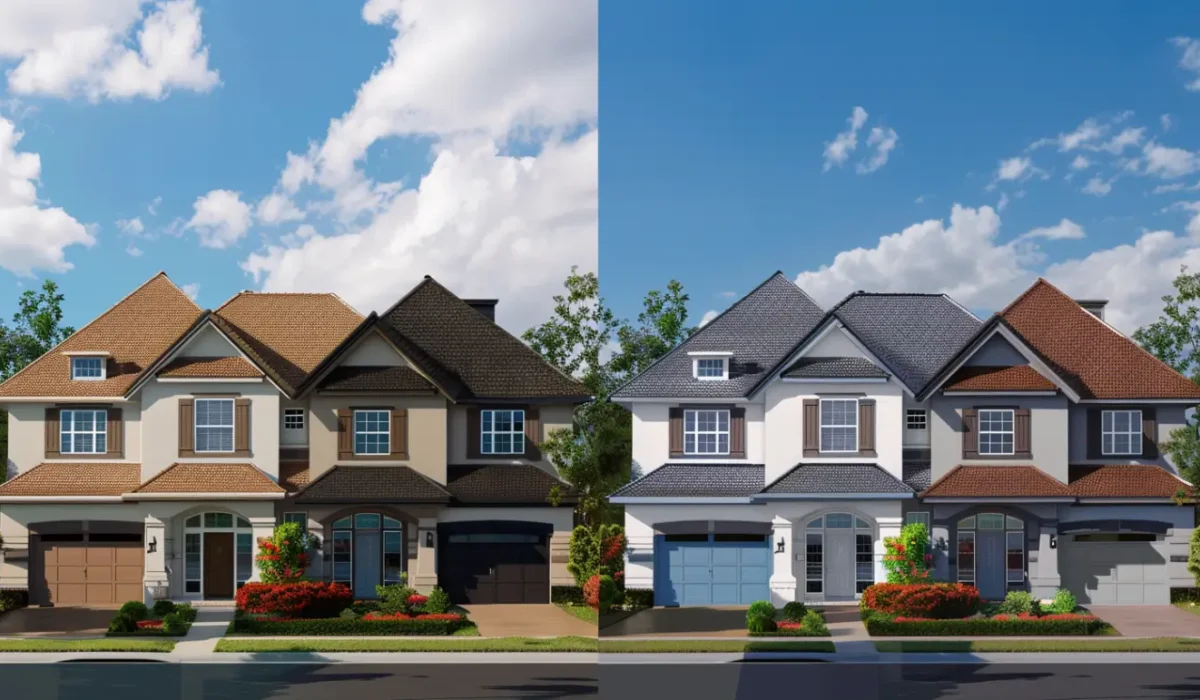When you pick a new roof, the color of your shingles is not just about looks. The roof color can change how well your home keeps cool or warm. This also affects your monthly bills. If you live in Grapevine, TX, making an informed decision can help you save money and make your indoor comfort much better. At KangaRoof, we do the right thing with quality and passion. We want you to know how roof color boosts your curb appeal and improves your home’s energy efficiency and performance.
The Role of Roof Color in Home Energy Efficiency
The color of your roof plays a significant role in your home’s energy efficiency by influencing heat absorption and reflection. Lighter colors tend to have higher solar reflectance, meaning they keep the attic and indoor temperatures cooler, particularly in warmer climates. This results in reduced energy consumption, ultimately leading to lower energy bills during the summer months. Conversely, darker roofs may retain heat, which could be advantageous in colder climates but may increase cooling costs in warmer regions.
Contact Us

Understanding Heat Absorption and Reflection
Heat absorption and reflection are crucial factors influencing a home’s energy efficiency. Lighter colors tend to reflect more sunlight, which helps keep indoor temperatures lower, particularly in warmer climates. In contrast, darker colors absorb heat, potentially increasing energy consumption for cooling during summer months. This distinction is pivotal for homeowners aiming to reduce air conditioning costs. Understanding these properties, along with the local climate, enables informed decisions when choosing roofing materials and colors to enhance indoor comfort and lower energy bills.
Impact of Roof Color on Summer and Winter Energy Bills
The color of your roof significantly influences energy bills throughout the year. In warmer months, lighter roof colors enhance solar reflectance, helping to reduce indoor temperatures and lower cooling costs by minimizing the demand on air conditioning systems. Conversely, during the winter, darker roofs are adept at heat retention, capturing warmth and maintaining comfortable indoor temperatures, which can decrease energy consumption. Selecting the right roof color tailored to local climate conditions promotes overall energy efficiency, ensuring cost-effective home management year-round.

Comparing Light vs. Dark Roof Colors
Light-colored roofs, known for their excellent solar reflectance, can significantly enhance a home’s overall energy efficiency, especially in warmer climates. By reducing heat absorption, these roofs lower indoor temperatures, ultimately decreasing air conditioning needs and energy bills. Conversely, darker roofs tend to absorb more heat, which may lead to increased energy consumption during summer months. However, in colder climates, darker colors can aid in heat retention, potentially offering benefits during winter months. Careful consideration of the local climate is essential for maximizing energy savings.
How Lighter Roofs Can Reduce Cooling Costs
A lighter roof color significantly enhances a home’s energy efficiency, especially in warmer climates. By utilizing cool roofing materials with high solar reflectance, these roofs minimize heat absorption, leading to lower indoor temperatures. Consequently, air conditioning systems can operate more efficiently, resulting in reduced energy bills during peak summer months. Choosing lighter colors not only contributes to lower energy consumption but also combats the urban heat island effect, benefiting both homeowners and the environment while enhancing overall indoor comfort.
Advantages and Drawbacks of Dark-Colored Roofs
Opting for dark-colored roofs presents both benefits and challenges. One advantage includes their ability to absorb heat, which can be beneficial in colder climates during winter months, enhancing indoor comfort by keeping attic temperatures warmer. However, this heat retention can lead to increased energy consumption and higher cooling costs during warmer months, particularly in hot climates. Such roofs may also exacerbate the urban heat island effect, affecting local climate conditions and overall energy efficiency. Prospective homeowners should weigh these factors carefully.

Roof Color and Curb Appeal: What Homeowners Should Know
Choosing the right roof color not only enhances a home’s aesthetic appeal but also can significantly influence its resale value. Lighter colors often complement contemporary design trends, while darker colors can convey a sense of elegance and stability. Combining personal preferences with reflective properties can create striking visual dynamics. Additionally, considering the local climate helps ensure that the selected roof color contributes to overall energy efficiency. Potential buyers may have their preferences, making this design choice a critical investment for homeowners.
Enhancing Exterior Style with the Right Roof Shade
Selecting the appropriate roof shade can significantly enhance your home’s curb appeal while contributing to its overall energy efficiency. Lighter colors, such as light gray or white, often create a striking and modern aesthetic that stands out in warmer climates. Conversely, darker colors, like dark brown or black, offer a classic look but can increase heat retention. Striking a balance between personal preferences and energy savings is essential, as the right roof color can also attract potential buyers during a resale.
Roof Color Choices That Boost Property Value
A well-chosen roof color can enhance curb appeal and significantly influence property value, appealing to potential buyers. Light colors, such as white or light gray, not only reflect heat but also contribute to a home’s overall energy efficiency by minimizing cooling costs, especially in warmer climates. Alternatively, opting for elegant dark roofs, like deep brown or dark gray, can create a striking visual contrast against lighter exteriors. Ultimately, the right roof color serves as a smart design choice that aligns with local climate, enhancing both aesthetic appeal and resale value.
What’s Next
In conclusion, selecting the right roof color significantly influences both energy efficiency and curb appeal. Lighter colors can enhance a home’s energy efficiency by reducing heat absorption, leading to lower energy bills, especially in warmer climates. Conversely, darker roofs may appeal aesthetically while contributing to higher cooling costs. Understanding the implications of roof color not only aids homeowners in achieving indoor comfort but also enhances the property’s resale value, making it a crucial design choice for property owners.
Frequently Asked Questions
Which roof colors are best for selling a house in Texas?
In Texas, roof colors like light gray, beige, and soft blue are popular for boosting curb appeal and attracting buyers. These shades complement the state’s sunny climate while enhancing energy efficiency. Darker colors may deter potential buyers due to heat absorption.
What is the most energy-efficient roof color?
The most energy-efficient roof color is typically light hues like white or pale gray. These colors reflect sunlight, helping to keep homes cooler in warm months, thus reducing cooling costs. Homeowners should consider local climate when choosing the best option for energy efficiency.
Does a black roof raise your electric bill?
Yes, a black roof can raise your electric bill. Its darker color absorbs more heat, leading to higher cooling demands in summer months. Consequently, homeowners may experience increased air conditioning costs as the indoor temperature rises, impacting overall energy efficiency and expenses.
Read our blog: Should You Consider a Reflective Roof for Your Home?
